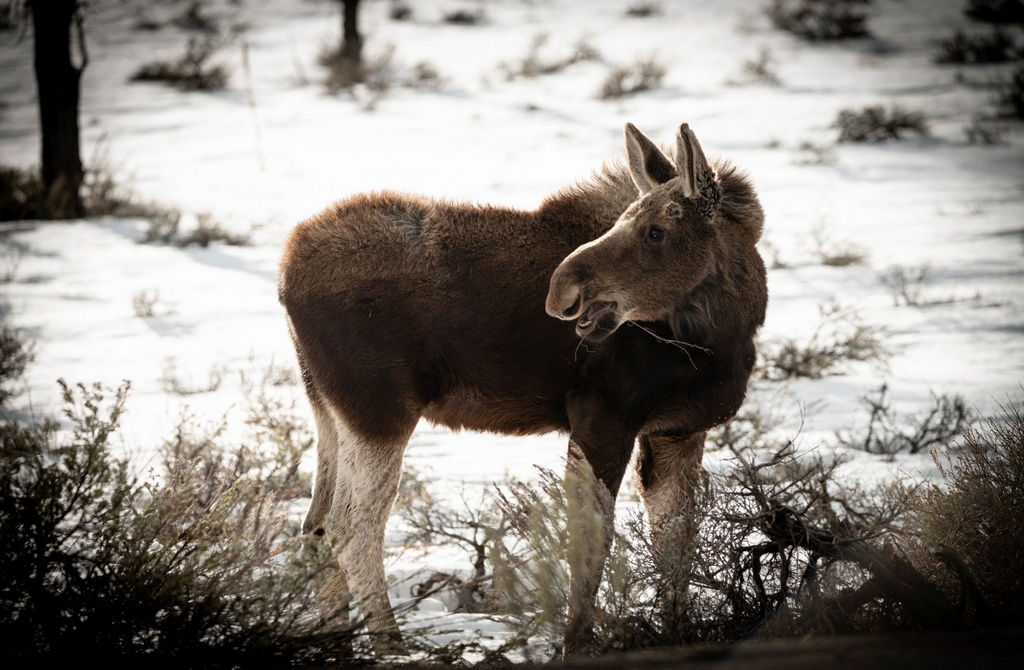General Description
The largest member of the family Cervidae, the moose, Alces alces, has a height range of 5 to 7½ feet (1.6 to 2.3 meters) and weight range of 600 to 1200 pounds (300 to 800 kilograms). The hips are lower than the hunches of the animal, as there is a slope from the shoulders to the rump. The long slender legs of the moose terminate with large, long and narrow hooves. The toes of the hooves are spread apart, which facilitates walking on swamps or marshes. Moose have a long brown coat that clings to them in the summer, whereas the winter coat is more dense with a bristly undercoat.
There is strong dimorphism in body size in the sexes; males of the species can be up to twenty percent larger than females. The male also has the largest set of antlers of any member of the deer family. The antlers are shed every year in November or December and are flattened with up to forty tines. Males have a dewlap, or bell, on the throat on which a beard grows as the animal matures. In the winter the presence of moose may be indicated by bark-stripped trees, a staple of the animal’s winter diet.
Geographical Distribution
Moose are found throughout northern parts of North America, Europe and Asia. They tend to live in deciduous forest, preferring to exist near water. Possibly due to the habitat requirements of raising young, females make more use of lowland forests and cut-over areas than males
Moose are found throughout Glacier National Park within forests, along lake sides and streams and even within bogs and marshes. The moose found in the park are members of the subspecies, Alces alces Americana, or common moose. Interestingly, the main predator of moose, the wolf, was absent in the park until the mid-80s, but there has been a slow reintroduction in recent years, estimating 6 to 8 packs within park boundaries.

Biology
Moose are ruminants, thus their diet is herbivorous, consisting of soft wood, branches, twigs, grasses and aquatic or march plants. Moose frequently trot, but seldom run. Surprisingly good swimmers, moose can swim upwards of 12 miles and are able to make significant dives of up to 19 feet (6 meters). This behavior has been adopted as foraging strategy for aquatic plants. As herbivores, moose compete with other members of the family Cervidae and small mammals such as rabbits and beavers.
An adult moose can run up to 35 miles per hour for shorter distances and average 20 miles per hour for longer runs.
Moose undergo a down regulation of metabolism in the winter months which results in a reduction in food consumption and subsequent weight loss. This adaptation helps moose to deal with the scarcity of food in their habitat during the winter. During these cold winter months groups of moose assemble together and tramp snow down to establish a “moose yard” where they can strip bark from surrounding trees.
The rut, or breeding season, begins in September with males fighting for mates. Males and females usually stay together for one breeding season. In seasons of high food abundance over ninety percent of female moose will become pregnant. One or two young are born in the spring after a 35 to 38 week gestation period. The young are nursed for nine to twelve months and the female cares for the young until the birth of another is imminent. Males of the species reach maturity by the age of five, while females reach maturity by the age of six and are most productive between the ages of six and twelve. The lifespan of moose can reach 25 years, however many do not reach that age due to hunting.

The home range of male moose is significantly larger than that of the female. This is due to two factors; males have higher metabolic requirements and males must also search for females to ensure reproductive success. Additionally, females are significantly less active than males. Predators of moose consist of wolves, black and grizzly bears. Bears prey primarily on moose calves which can have a significant impact on moose populations. If attacked moose are capable of defending themselves with their sharp hooves. In fact, a moose is capable of stabbing a predator to death with a blow from its hooves.
Aggressive Behaviour
Moose are generally not aggressive towards humans but like most wild animals they can be frightened, resulting in unpredictable behaviour including aggression. Some considerations include; moose that have been fed by humans, bulls during mating season, and cows with calves. Moose do not view humans as food and generally wouldn’t attack on that basis.
Moose will show aggression towards other animals, especially predators.
Population
In United States there are an estimated 300,000
Alaska: The state’s Department of Fish and Game estimated 200,000 in 2011
Northeast: A wildlife ecologist estimated 50,000 in New York and New England in 2007, with expansion expected
Rocky Mountain states: Wyoming is said to have the largest share in its six-state region, and its Fish and Game Commission estimated 7,692 in 2009
Upper Midwest: Michigan 2000 on Isle Royale (2019) and an estimated 433 (in its Upper Peninsula) in 2011, Wisconsin, 20-40 (close to its border with Michigan) in 2003, Minnesota 5600 in its northeast in 2010, and under 100 in its northwest in 2009
In Canada there are an estimated 500,000 to 1,000,000 moose, with 150,000 in Newfoundland in 2007 descended from just four that were introduced in the 1900s
Source: https://en.wikipedia.org/wiki/Moose
Sightings
Inside the park, the most common areas to spot moose are McDonald Creek in the Moose Alley area, Fishercap Lake, Swiftcurrent Lake, Lake Josephine and Two Medicine Lake.
Again, like most wildlife, it’s advised that you enjoy the view from a distance and never attempt to feed.










































![Air gun 101: The differences between .177 & .22 – Which jobs they do best ? [Infographic]](https://airgunmaniac.com/wp-content/uploads/2020/09/g44-150x150.jpg)

